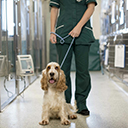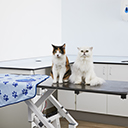Tips, tricks and advice from Pauline; a Petplan team member & veterinary nurse with over 30 years’ experience and expertise
Introducing Pauline

Pauline is pet mum of 8 rescue animals; 2 dogs, 4 cats and 2 Guinea pig’s, a qualified veterinary nurse for 31 years and a member of the Petplan team for 19 years – working part-time in practice and with Petplan.
With her love of animals, Pauline also takes part in a lot of charity work such as neutering clinics. Take a look at her top 3 tips for calming your pets nerves below.

Helping your dog relax when visiting the vet
1. Be prepared. Most practices will allow you to pop in and say hello without an appointment. Do this when you can, to make a trip to the vets a normal experience and one that does not always result in a consult. Take your treats and make a fuss of your dog while you are there
2. Invest in a calming spray or collar. These are widely available and can really help your dog to relax during their veterinary visit
3. Manage your emotions. If you’re feeling anxious or worried try to remain calm and positive, your dog will almost certainly suspect something is wrong if you are feeling un-easy

Helping your cat relax when visiting the vet
1. Love the crate. Including a crate into your cats normal routine as a snuggly safe space can really help when you need to take your cat somewhere. If this is not something you have already established, have the crate out at least 2 days before the vet visit
2. Cover the crate. Keeping the crate covered with a towel and using a calming spray on it will make the space feel even safer for your cat. Remember to keep the cat inside the crate during the journey and in the waiting room, until you are with the vet
3. Give them a smooth journey. Be sure not to bump and wobble the crate whilst transporting your cat and keep it up high when in the practice. Putting it on the floor often seems like a sensible place but it could leave it exposed to other animals especially dogs who may want to sniff it in the waiting room.
In addition to these tips, it is important to consider how best to work with your practice, often there are separate areas for dogs and cats to wait in, or a quiet cat corner. Think about your pet too, if you have a partially boisterous dog or one that becomes anxious around other dogs it may be best to wait outside the practice or in the car.
For more advice on supporting your pet when visiting the practice visit:

